
When I was a kid, we lived at the end of a very long road in the country. Not so far out that we required a guide, but deep enough in that some relatives were afraid to visit.
Although we lived a good distance away from any city or town, we were by no means the only family in the outskirts. Granted, most were cottagers who made only brief appearances once a year, but there were also few permanent residents living amongst the wildlife.
However, they were nothing like us.
There were the Smiths* - a rather uptight crew of five who had escaped life in the big city to settle in a lakefront mansion. At least, I thought it was a mansion. I had little to go on other than the fact that my house had one level and theirs had two (and a half). The Smith dad - a doctor – ran past our house and up and down our long country road every day before dawn, at noon, after supper and when the sun went down until one day he never came back. The Smith mom was a snob (by my family’s standards) and by that I mean that she never spoke to us, even though her daughter was my best friend - but only during school hours, on Tuesdays.
Then, there was the Jones Family* who lived near enough that when conditions were right, we could inhale their cigarette smoke. All four of them had loud voices, and as a result, we always knew what they were having for supper, which child had misbehaved that day, and who had a headache. Residing near them was exhilarating. And exhausting.
Still, living where we did brought with it benefits.
For example: At the first sign of precipitation, all buses were pulled off the roads, mostly because the rural snowplow driver couldn't keep his rig from sliding into the fields. Good heart, heavy foot that one. This meant that us country kids rarely attended school in the winter, even though our school never closed.
However, living where few dared meant that we were slightly behind when it came to technological advances.
We had a telephone, but it was what was known as a "party line” which meant that in order to use it, we had to wait for Agnes who lived two rural routes over, to stop chatting with her friend Mabel. We had a television set, but could only see two channels. All news. When cable hookup finally arrived in my pre-teen years, I didn’t sleep for a week. It was amazing, until something rabid chewed the outside line going into our house.
Because we had no prepackaged sources of amusement, we country kids made our own fun. Entertainment out there was different than in the city, but it was readily available. Day or night.
Animal sightings were common, including that one time we all stood in amazement as a skunk moseyed in front of us with a soup can on his head. Also, I had a pet squirrel, a pet raccoon, pet rabbits, and pet frogs. And by this I mean I fed wild animals from our back deck until one day, when they all tried climbing up the screen door at the same time.
It was a bloodbath.
Power outages were typical, as were evening dinners made on a camp stove, toys made of sticks and buckets full of worms. And sometimes - if we were lucky - an ice fisherman would mistake our backyard for a toilet, likely convinced our home was an uninhabited cottage.
Eventually though, things evened out when my father brought home our first computer. It was the size of a refrigerator and could be programmed to display the word “hello” in white type on a black background.
It was amazing and it signaled the dawn of a very different world.
When I look at my daughter, I can’t imagine her growing up without computers, iPods, Netflix, mobile phones and indoor plumbing. Still, our recent move back to the country (at the end of another very long road) has given us a chance to show her that there is more to life than a dedicated telephone line.
Every evening we watch the deer wander past our window, coyotes sometimes scoot past the fire pit and bear scat keeps us on our toes. Pet crickets are routine, beach rocks are playthings and a pile of sand is still the best toy any kid could ever ask for.
Sure, we also share our home with My Little Pony, Little Live Pets and Paw Patrol and sometimes, as I scan my kid’s bedroom, I shudder at the glut of purchased playthings. But at the end of the day, I like to think we are providing our girl with a healthy understanding of what’s important. Namely: experiencing nature, playing make-believe and always - ALWAYS - keeping the raccoons separate from the rabbits.
*names have been changed.
Image Source: Google Maps

Seven-year-old Alia lives in San Francisco, and like a lot of kids her age, she loves rainbows.
Last December, Alia - inspired by the Monteiro Family’s Word Rocks Project - decided to scatter rocks painted with colourful rainbows and embellished with cheerful messages, all around her neighbourhood.
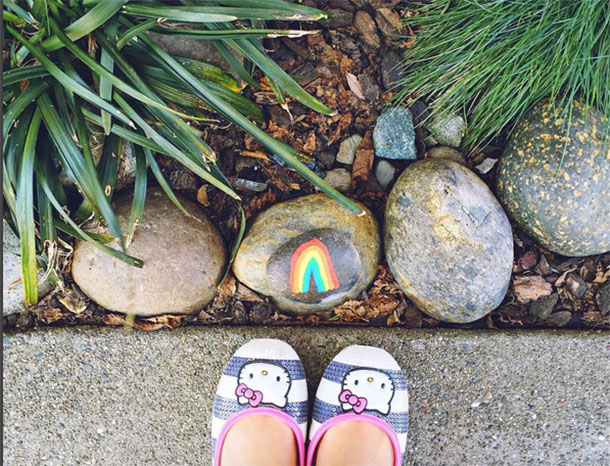
Her goal was to spread joy and make people feel happy when they discovered one of her creations on the sidewalk, at the park, on hiking trails, on mailboxes, and at local attractions.
Shortly after, Alia’s mom Agnes suggested Alia begin painting the rocks for a good cause. And with that, the Rainbow Rock Project was born.

A website was created where, for a dollar a piece, donors could have Alia decorate a rock and place it where it would bring joy to a stranger, with all proceeds going to a cause of Alia’s choosing.
“When we are driving around,” says Alia, “I sometimes see homeless people on the street. I always ask my mom or dad to stop and give them money. I feel bad that there are so many homeless people out in the cold without food or a warm bed."
And so, Alia set a goal of selling 500 rocks this year, giving all the proceeds to her local homeless shelter, Bay Area Rescue Mission.
But, here’s the thing. Shortly after the project began, Agnes shared her daughter’s beautiful rocks with her Instagram followers and within two days, 500 rocks were sold to people from Australia, England, France, Canada, Singapore and the USA.
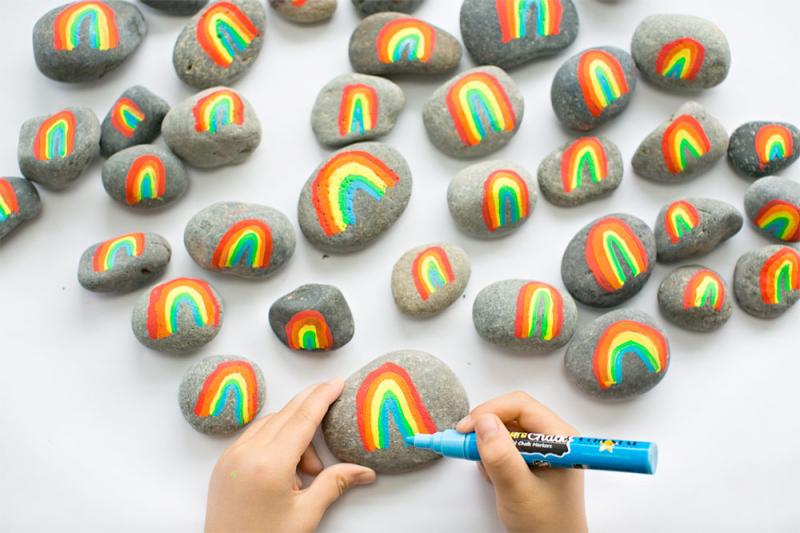
Alia’s new goal is now 1000 rocks, and her parents have pledged to personally match donations if she reaches it, meaning $2000 will potentially be donated to The Bay Area Rescue Mission.
Every rock is painted by Alia using Fun Chalk markers (who were kind enough to donate markers for the cause). The rock - including the message on the back - is then sealed so the rain won’t wash away the cheerfulness. Because so many rocks sold so quickly, Alia has enlisted the help of her friends to paint them as soon as possible.
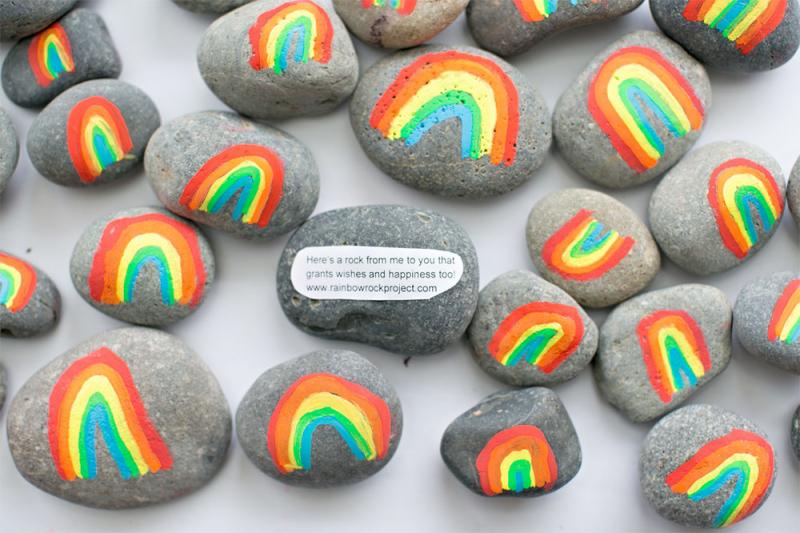
Meanwhile, Alia and her mom would love it if other people – especially kids - would join them in spreading kindness around their home communities. All you need to do is find and decorate your own rainbow rocks and drop them around your cities and towns. And when you do, be sure to share them on Instragram at @rainbowrockproject by using the hashtag #rainbowrockproject so Alia and her mom can see and share back. She says, “I would love other kids (and grown-ups) to get involved so we can scatter as many rainbow rocks as possible around the world!”
When I told my seven-year-old daughter about the Rainbow Rock Project, she immediately began planning. When the snow clears, she will be collecting, decorating and spreading pretty stones (and good thoughts), all over our town with an additional goal to raise funds for our local SPCA.
What about you? Will you and your kids join in on these random acts of kindness?
![]() RELATED: This Mom Made A Rainbow Loom Dress That Sold For More Than $200,000
RELATED: This Mom Made A Rainbow Loom Dress That Sold For More Than $200,000
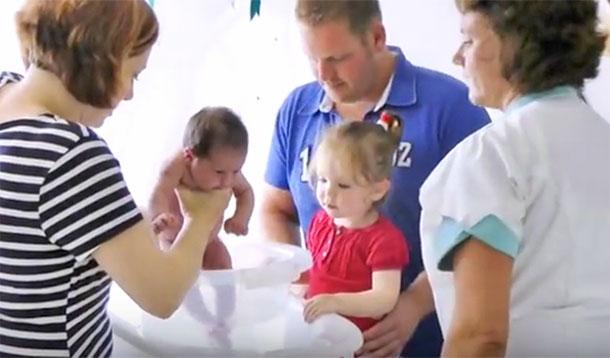
The hour-long drive home from the hospital where my daughter was born was fraught with danger.
First, there was my perineum (if you have to ask, you just don’t get it). Then, there was the night sky, which meant that for the first time since her birth, I was unable to keep constant watch over my infant. The bumpy road and unfamiliar sounds and smells led to the overwhelming realization that I was in need of another painkiller and had exactly zero experience keeping a miniature human being alive.
Fortunately, when my baby and my equally inexperienced husband and I arrived at our house, my parents were waiting for us - with a walker - because childbirth was crippling.
I was lucky. Having a close relationship with my mom meant having someone to commiserate with, learn from, and hand the crying newborn to when it was time for a date with my sitz bath. It made those confusing, exhausting and worrisome days immediately following delivery all the more pleasant.
However, because of death, distance, or disaffection, not everyone has the luxury of a supportive mom.
Enter the Dutch, who have come up with a better alternative.
It’s important to note that two things happen when you give birth in Holland.
ONE:
New parents are expected to provide visitors with beschuit met muisjes which roughly translated means rusk with little mice. The Dutch are a strange bunch. I know because I am one. The treats are not rodents, but rather sweet crackers, lathered with butter and sprinkled with anise-flavoured candies (blue for baby boys, pink for baby girls). It’s a tradition that dates back to the 17th century. The anise is thought to stimulate lactation, so I’m not entirely sure why everyone in the neighbourhood is required to consume it (other than the fact that it is so delicious).

TWO:
A highly trained Mary Poppins comes to your house and brings you and your family breakfast in bed (and then some).

The Dutch are of the opinion that friends or relatives cannot (and should not) take on the task of helping new mothers with their newborns. Reason being, if problems develop during the first days after childbirth, an expert should be close at hand. And so, in The Netherlands (as in other European nations) when you become a moeder (mom), a highly trained kraamverzorgster (maternity nurse) will come to your home and help you take care of your baby for 24 to 80 hours over a period of up to ten days. And, as of 2006, this service is available to all, as part of basic health insurance.*
In Holland, medical insurance is mandatory, which means EVERYONE has it, and those who can’t afford it are subsided by the government. This common sense approach is part of a bigger picture. It’s preventative medicine, as it should be practiced.
My Dutch cousin delivered both of her boys at home with the help of a midwife, making her part of the 33% of women who give birth at home every year in The Netherlands. Henriette received five days of kraamhulp (maternity assistance) with her eldest son and three days with her youngest. “They came by every day” she says, “and helped me to take care of the babies, answered questions and told visitors to leave when they had stayed too long.”
Kraamverzorgsters guide and support pregnant mothers during the final stages of their pregnancy, assist the doctor or midwife during delivery, and help the mother in the first hours after delivery (much like maternity nurses in North American hospitals).
However, unlike in North America, in Holland the maternity nurses follow you home like happy, helpful stalkers.
Once settled in, they perform many tasks including:
 Helping the mother and the baby by doing daily check-ups.
Helping the mother and the baby by doing daily check-ups.
 Providing support and tips about breast (or bottle) feeding and general baby care including waking/sleeping patterns, comfort, SIDS and allergy prevention, hygiene and schedules.
Providing support and tips about breast (or bottle) feeding and general baby care including waking/sleeping patterns, comfort, SIDS and allergy prevention, hygiene and schedules.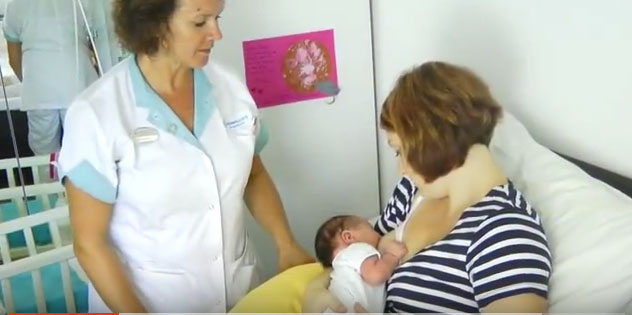
 Assisting with older children in the house and incorporating them into the daily rhythm of baby care.
Assisting with older children in the house and incorporating them into the daily rhythm of baby care.
 Performing ordinary household tasks such as cleaning and food preparation.
Performing ordinary household tasks such as cleaning and food preparation.

 Acting as hostess when guests come to call.
Acting as hostess when guests come to call.
 Ensuring both parents get sufficient rest.
Ensuring both parents get sufficient rest.
 Observing, monitoring and reporting back to the doctors and midwives.
Observing, monitoring and reporting back to the doctors and midwives.
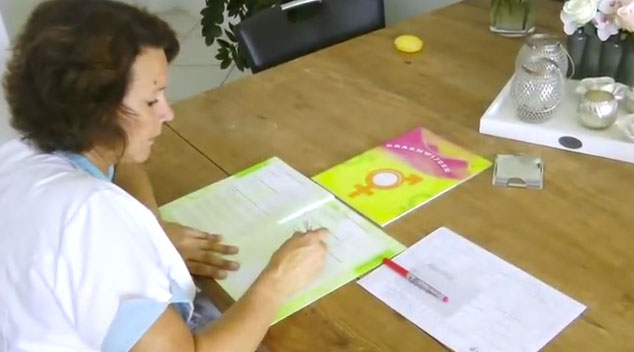
 Recognizing physical and mental health issues with the mother and baby.
Recognizing physical and mental health issues with the mother and baby.
 Identifying families at risk so that they might receive the assistance they require.
Identifying families at risk so that they might receive the assistance they require.
This kind of individually tailored postnatal care gives mothers in Holland confidence in their abilities by allowing them to focus on their babies without worry, which makes kraamzorg (maternity care) practically perfect in every way, not unlike my push present.
Prune juice, in case you were wondering.
*There are many maternity care choices in The Netherlands (including both organizations and individuals) and the type of care one receives (choosing your own nurse, having someone stay with you for longer than 24 hours or having your nurse take care of your older children, for example) depends to a certain extent on familial requirements and whether or not families have paid for extended health coverage. However, essential maternity care is provided even with basic plans. One thing that is consistent is the three years of training a kraamverzorgster receives.
Photos of kraamverzorgster with family: Kraamzorg Zuid-Gelderland/YouTube
Beschuit met muisjes photo: FreeImages.com/Sven van der Spree
![]() RELATED: Why Are Families in The Netherlands Happier Than Us?
RELATED: Why Are Families in The Netherlands Happier Than Us?